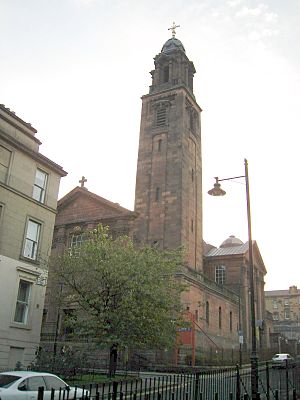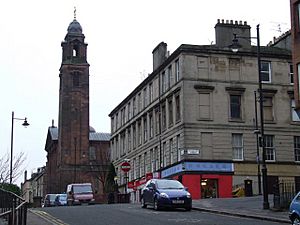St Aloysius Church, Glasgow facts for kids
Quick facts for kids St Aloysius Church |
|
|---|---|

View of church along Hill Street
|
|
| Lua error in Module:Location_map at line 420: attempt to index field 'wikibase' (a nil value). | |
| OS grid reference | NS586660 |
| Location | Glasgow |
| Country | Scotland |
| Denomination | Roman Catholic |
| Website | St Aloysius Parish, Glasgow |
| History | |
| Status | Active |
| Founded | 1868 |
| Founder(s) | Fr William Kay SJ |
| Dedication | St Aloysius Gonzaga |
| Consecrated | 29 November 1953 |
| Architecture | |
| Functional status | Parish Church |
| Heritage designation | Category A |
| Designated | 15 December 1950 |
| Architect(s) | Charles Menart |
| Style | Baroque Revival |
| Groundbreaking | 4 October 1908 |
| Completed | 6 February 1910 |
| Specifications | |
| Capacity | 800 |
| Length | 150 ft (46 m) |
| Width | 90 ft (27 m) |
| Nave width | 44 ft (13 m) |
| Height | 60 ft (18 m) |
| Spire height | 150 ft (46 m) |
| Administration | |
| Deanery | West End |
| Archdiocese | Glasgow |
| Province | Glasgow |
St Aloysius Church is a Roman Catholic church located in the Garnethill area of Glasgow, Scotland. It's a special church because it's the only one in Glasgow managed by the Society of Jesus, also known as the Jesuits. You can find it on the corner of Hill Street and Rose Street, right next to St Aloysius' College, Glasgow. The church and the school work closely together. When it was first built, it was the only Catholic church in Glasgow with a tall tower! Its design is inspired by Namur Cathedral in Belgium. It's also a very important historical building, listed as Category A.
Contents
History of St Aloysius Church
How the Church Started
The Jesuits are a group of Catholic priests. They first came to Glasgow in 1859. They took over a church called St Joseph's. In the early 1860s, they bought some land in the Garnethill area. At that time, Garnethill was a new part of the city where wealthier families lived.
In 1868, a priest named Fr William Kay SJ arrived in Garnethill. His job was to start a new church called St Aloysius. He quickly built a large iron and glass building on Hill Street. People called it 'Fr Kay's Railway Shed' because it looked a bit like a train station. This building was used as the main church for about 40 years.
The Sisters of Mercy also came to Garnethill in 1868. The Jesuits invited them. They rented two houses on Rose Street, which is where the church stands today. The sisters helped at the primary school next to St Joseph's church.
Building the Current Church
The first stone for the church you see today was placed on October 4, 1908. The church officially opened on February 6, 1910. Archbishop John Maguire of Glasgow led the opening ceremony.
The church is a very important historical building, listed as Category A. It was designed by a Belgian architect named Charles Jean Ménart. He designed it in the Baroque Revival style. This style looks grand and dramatic. St Aloysius Church was special because it was the only Catholic church in Glasgow with a tower. Its design was inspired by Namur Cathedral in Belgium and the Gesu in Rome.
The church tower has two bells. They were put there in 1910. These bells had an interesting journey! They were originally part of a set of 10 bells from St Giles' Cathedral in Edinburgh. In 1890, St Giles' Cathedral sold them to St Mary's Cathedral in Edinburgh. St Mary's wanted to build a tower for the bells, but they couldn't raise enough money. So, in 1910, the bells were split up and given to different churches. Two of them came to St Aloysius Church.
Inside the church, there are four smaller chapels. These are The Sacred Heart Chapel, the Lady Chapel, the Holy Souls Chapel, and the St Ignatius Chapel. There is also a special area called the St John Ogilvie national shrine. This shrine was added in 1933 to honor John Ogilvie. He was recognized as a saint in 1929.
Decorating the inside of the church took a long time and cost a lot of money. It wasn't until after the Second World War that all the costs were paid off. On November 29, 1953, Archbishop Donald Campbell led a special ceremony to officially make the church sacred.
The Black Madonna Statue
In February 2008, a special statue was given to the church. It's a copy of the famous statue of Our Lady of Montserrat, also known as The Black Madonna. Visitors from Spain donated it. This statue is in the Lady Chapel. It's only the second such statue outside of Catalonia, Spain.
Church Community and Activities
St Aloysius Church has a very close connection with St Aloysius' College next door. The school often uses the church. For example, school assemblies are held in the church twice a week because it's so big. Masses (church services) are also regularly held in the church for both the younger and older students.
Next to the church is the Ogilvie Centre. This center hosts many groups connected to the church community. For example, it's home to the local Christian Life Community and a social justice group.
There's also the Ignatian Spirituality Centre nearby, at 35 Scott Street. This center is in the same building where the local Jesuit priests live. It used to be in Hamilton and was called the Craighead Jesuit Spirituality Centre. It moved to Glasgow later and was renamed. The center offers guidance and different programs based on Ignatian spirituality. This helps people explore their faith. The center has a team of Jesuits, other religious people, and volunteers from different Christian groups.
Inside the Church
See also
- List of Jesuit sites
- St Aloysius' College, Glasgow
- Ignatian spirituality




